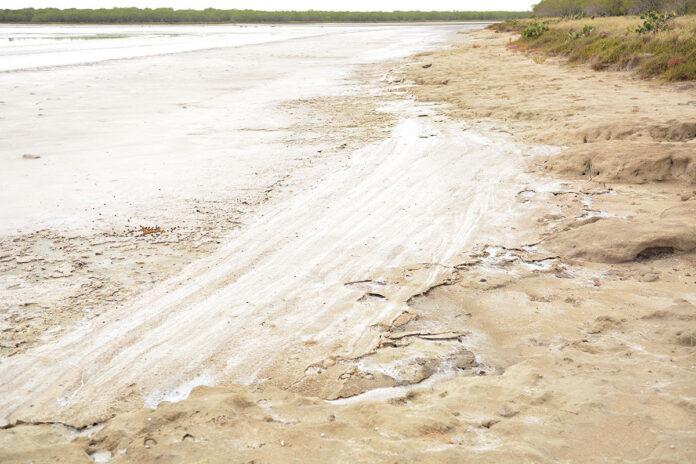SAN MANUEL — You might say the hypersaline lake known as El Sal del Rey was the Valley’s first tourist attraction.
Located west of Raymondville in Hidalgo County, the lake sits atop an estimated 4 million tons of salt, a critically valuable commodity to Native Americans as well as the Europeans who came later.
Today, standing on the shoreline of the briny shallows of El Sal del Rey, the scene is probably eerily similar to what those salt traders saw centuries ago.
One has a sense that history happened here, a history far deeper and more extensive than the mere European conquest of a continent.
The mile-long lake these days, diminished by the sun over a hot, dry summer, has shrunk to about half its full size and one can walk across the dry expanse.
The lake bed consists of a thin layer of tawny sand covering deep black soil, a landscape carved up by thousands of hoofprints of nilgai antelope and white-tailed deer.
Yet there are few living things to be seen here beyond a bounding, fork-horned, white-tailed buck crossing the caliche trail that leads to the lake, and three great egrets standing silently in white splendor along the shore.
For the rest of this story and many other EXTRAS, go to our premium site, www.MyValleyStar.com.
Subscribe to it for only $6.99 per month or purchase a print subscription and receive the online version free, which includes an electronic version of the full newspaper and extra photo galleries, links and other information you can’t find anywhere else.
One of three hypersaline lakes in Texas.
The lake covers 530 acres but ebbs and grows with rainfall. Sodium chloride content is 99 percent, 10 times saltier than the ocean. Estimated 4 million tons of salt at the lake site. The lake is about one mile long and five miles in circumference. The
lake is about 3 to 4 feet deep.
The salt lake has been a source of salt for hundreds if not thousands of years, first by aboriginal peoples and later by the Spanish and Texans.
Salt was mined at the site up to the 1930s.
Aztecs from as far away as the current site of Mexico City came for the salt, carrying it out on foot.
Claimed as “The Salt of the King” by early Spanish colonists in 1746 because all minerals belonged to the king of Spain.
It was a critical source of salt for the Confederates in the Civil War.
The Confederates brought in camels to haul the salt out to the Gulf coast.
Designated on the National Register of Historic Places.
Designated a “Site of International Significance” as a migratory stopping area for shorebirds.
El Sal del Rey is located on State Highway 186, about four miles east of San Manuel.
The main access point has a parking area and trail head.
No vehicles are allowed past the parking lot.
It is at least a one-mile hike to the lake on a caliche trail.
Take plenty of water.
Wear long pants and long sleeves and bring bug repellent to counter the aggressive, biting sandflies.
Open year-round, from sunup to sunset.
Dogs on a leash are allowed.
No admission charge.
For more information, call the Lower Rio Grande Valley National Wildlife Refuge at 956-784-7500.




